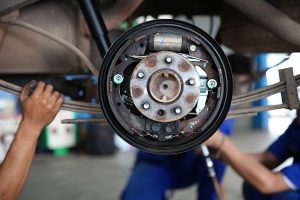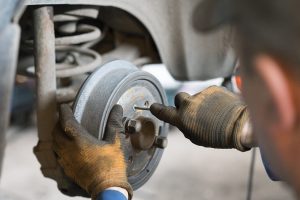Brake drums are an essential part of many vehicle braking systems, particularly on rear-wheel-drive cars and trucks. While disc brakes have become increasingly popular, drum brakes remain widely used due to their durability and cost-effectiveness. However, like all mechanical components, brake drums are prone to wear and issues over time. Understanding the common problems and knowing how to address them can improve safety, prolong component life, and enhance overall braking performance.
Typical Brake Drum Issues

-
Surface Wear and Grooves
-
Symptoms: Vibration during braking, uneven pedal feel, squealing or scraping noises.
-
Cause: Normal wear and tear, accumulation of debris between the drum and brake shoes.
-
Solution: Minor grooves can be machined by a professional, but deep or excessive wear usually requires replacement of the brake drum.
-
-
Overheating (Brake Fade)
-
Symptoms: Reduced braking power after repeated stops, burning smell, or smoke near the wheels.
-
Cause: Extended braking under heavy loads or high speeds can cause the drum to overheat, reducing friction efficiency.
-
Solution: Allow brakes to cool after heavy use, avoid constant braking downhill, and consider high-performance or vented drums for vehicles used in demanding conditions.
-
-
Out-of-Round Drums (Drum Runout)
-
Symptoms: Pulsation in the brake pedal or steering wheel, uneven braking, vibrations.
-
Cause: Uneven wear, improper installation, or thermal expansion.
-
Solution: Minor runout can sometimes be corrected by resurfacing. Excessive runout requires replacing the drum.
-
-
Contaminated Brakes
-
Symptoms: Slippery pedal, poor stopping power, unusual noises.
-
Cause: Oil, grease, or brake fluid contamination on the brake shoes or drum surface.
-
Solution: Thoroughly clean the brake assembly with brake cleaner and replace contaminated shoes if necessary. Prevent leaks in the hydraulic system.
-
-
Cracks or Structural Damage
-
Symptoms: Noise, vibration, reduced braking efficiency.
-
Cause: Excessive heat cycles, over-torqued lug nuts, or poor-quality materials.
-
Solution: Cracked drums should always be replaced; welding or repairs are unsafe due to the high stress brake drums experience.
-
How to Address Common Brake Drum Problems
Tools Required:
-
Floor jack and jack stands
-
Lug wrench
-
Socket set
-
Brake drum puller (if needed)
-
Brake cleaner
-
Replacement brake drums and shoes
Step-by-Step Repair Guide:
-
Safety First
-
Park on a level surface and engage the parking brake.
-
Slightly loosen the lug nuts before lifting the vehicle.
-
-
Access the Brake Drum
-
Lift the vehicle and secure it with jack stands.
-
Remove the wheel to expose the brake drum.
-
-
Inspect the Drum
-
Check for grooves, cracks, and runout.
-
Measure drum diameter and compare it with manufacturer specifications.
-
-
Remove the Drum
-
If stuck, use a drum puller.
-
Clean dust and debris with brake cleaner.
-
-
Replace or Resurface
-
Resurface slightly worn drums to remove minor grooves.
-
Replace heavily damaged or out-of-spec drums.
-
-
Check Brake Shoes
-
Inspect shoes for wear and contamination.
-
Replace if necessary, ensuring correct alignment.
-
-
Reassemble the System
-
Install the drum and wheel, tighten lug nuts, and lower the vehicle.
-
Pump the brake pedal to ensure proper shoe seating.
-
-
Test Drive
-
Drive at low speed to check for proper braking and pedal feel.
-
Preventive Maintenance Tips
-
Regular Inspection: Examine brake drums and shoes at least every 12,000–15,000 miles.
-
Avoid Overloading: Excessive weight accelerates wear.
-
Proper Bedding-In: Follow the manufacturer’s instructions for new drums and shoes.
-
Use High-Quality Parts: OEM or trusted aftermarket components ensure longevity and reliability.
Comparison of Brake Drum Issues and Remedies
| Problem | Signs | Recommended Fix | Notes |
|---|---|---|---|
| Surface wear & grooves | Vibration, squeal | Resurfacing or replacement | Minor grooves can be machined |
| Overheating | Fade, smell, smoke | Cool down, high-performance drums | Frequent heavy braking requires heat-resistant drums |
| Out-of-round drum | Pedal pulsation | Resurface or replace | Runout should meet spec limits |
| Contamination | Slippery pedal, noise | Clean or replace shoes | Prevent hydraulic leaks |
| Cracks | Noise, reduced braking | Replacement only | Unsafe to repair |
Recommended Brake Drums

High-quality brake drums are critical for safe and effective braking. Some reliable options include:
| Product | Price (UAH) | Best Use | Notes |
|---|---|---|---|
| RAYBESTOS 2515 Rear Drum | 2,010 | Standard Replacement | Durable and trusted brand |
| ACDelco 18B80 | 2,482 | Premium | High-quality OEM standard |
| Centric C-TEK | 1,769 | Budget-Friendly | Reliable and cost-effective |
| PowerStop KOE15380DK | 10,342 | Complete Rear Overhaul | Kit includes shoes & hardware |
| Brembo 14.5815.10 | 1,408 | High-Performance | Excellent for heavy-duty vehicles |
You can explore these and buy Brake Drum online at Elartcom Brake Drums.
Conclusion
Brake drum issues, if ignored, can compromise your safety and braking efficiency. Early detection and proper maintenance—inspection, cleaning, resurfacing, or replacement—ensure your braking system functions effectively. Regular attention to drum condition and brake shoe wear will provide reliable stopping power, reduce repair costs, and extend the life of your brake system.